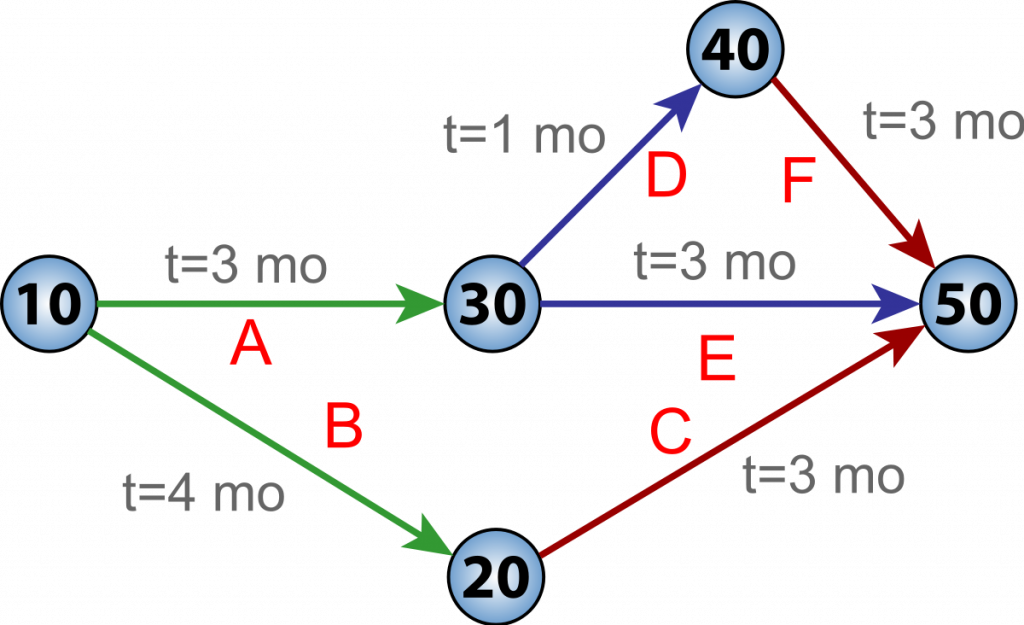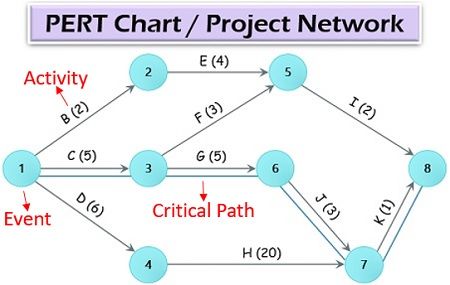
- Introduction to Project Evaluation and Review Technique
- What might PERT do for us?
- The three assessments utilized are
- History of PERT
- PERT Estimation Technique
- PERT includes statistical analysis
- Utilize PERT strategy for more precise appraisals
- Reason for PERT Analysis
- Features
- Instructions to Conduct a PERT Analysis
- PERT and Project Management
- The Three Chances
- Formulas Associated with PERT Estimation Technique
- Step by step instructions to Evaluate the Critical Path
- How to Make a PERT Chart
- Advantages and Disadvantages of PERT Analysis
- Certification cost
- Conclusion
- Energetic Estimate (E) depends on the weighted normal and follows beta conveyance.
- E = (O + 4 × M + L)/6
- All ventures rely upon assessments. We need to appraise the time it will take to finish a movement and we want to gauge the expense that will be brought about in executing an action, stage, or task. Gauges are approximations or “most realistic estimations” and are dependent upon the vulnerability with which we are faced while making these appraisals.
- From this we can see that the more vulnerability there is, the less precise our speculation is, and subsequently the higher the danger is that our time and quotes won’t be sensible. Would it be a good idea for us we just depend on one assessed figure, for example, “it will require 8 days to finish the action”, then, at that point, we won’t think about the vulnerability. To put it plainly, PERT is a strategy that assists us with considering this vulnerability while arranging sensible evaluations of our activities.
- In 1958, the U.S. Naval force presented network planning methods by creating PERT as an administration control framework for the improvement of the Polaris rocket program. Energetics’ center was to give supervisors the resources to plan and control cycles and exercises so the undertaking could be finished inside the predefined time. The Polaris program included 250 prime project workers, above 9,000 subcontractors, and countless errands.
- Energetic was presented as an occasion arranged, the probabilistic procedure to build the Program Manager’s control in projects where time was the basic variable and time gauges were hard to make with certainty. The occasions utilized in this method address the beginning and finish of the exercises. Saucy uses three-time gauges for every action: optimistic, skeptical, and doubtlessly. A normal time is determined given beta likelihood dissemination for every movement from these appraisals
- Saucy (Program Evaluation Review Technique) is an assessment strategy that was first evolved and applied by the United States Defense Foundation for their Ballistic Missile advancement program. It was one of their most aggressive projects. The culmination of this on schedule, in front of different countries, was basic for them.
- Such a rocket improvement program was loaded up with a tremendous measure of vulnerability, as it required a huge number of provider organizations chipping away at innovation advancement. This technique for assessment assisted them with working on every one of the vulnerabilities in their evaluations and assisted them with finishing this program in front of their normal timetable.
- PERT utilizes a three-point assessment approach for an errand. Any assignment loaded up with vulnerabilities can have a wide scope of gauge where the undertaking really will get finished. Vulnerabilities incorporate both great conditions (open doors) as well as ominous conditions (dangers).
- For instance, on the off chance that we ponder an assignment which includes going in a packed city from a particular area in the city to the air terminal. Genuine-time taken will rely upon the traffic condition upon the street.
- This might require optimisticly 30 minutes, skeptically an hour and a half, and most likely estimates an hour. So, the reach wherein the movement time will fall is 30 minutes to an hour and a half.
- E (Mean PERT Average) = (O+4ML+P)/6 (by giving more weightage to in all probability gauge)
- Standard Deviation (SD) = (P-O)/6
- The most pessimistic (P) situation when everything turns out badly
- The most optimistic (O) situation where everything goes right
- The most probable (M) case offered ordinary issues and chances
- For instance, suppose you gauge a piece of work to doubtlessly require 10 hours. The best case (everything goes right) is six hours. The most pessimistic scenario (everything turns out badly) is 26 hours. The PERT gauge is (6 + 4(10) + 26)/6. The response is 72/6, or 12 hours. Notice that the number was pulled a little toward the furthest limit of the pessimistic gauge, however just barely, since the outcome is as yet weighted intensely toward the most probable worth.
- You can utilize the PERT assessments in two different ways. You can give these three assessments to movements of every kind in your timetable or you can involve the PERT recipe for those exercises that are of high danger. There you’re not entirely certain of the gauge so there’s a wide variety between the optimistic and pessimistic qualities.
- Talking about variety – on the off chance that you take away your critical worth from the optimistic worth and separate the outcome by six, you would have the standard deviation, which is a proportion of the instability of the gauge. In our model over, the standard deviation would be 3.34 ((26 – 6)/6). The bigger this standard deviation is, the less certainty you have in your gauge since it would mean you have an enormous reach between the optimistic and skeptical evaluations. Assuming the standard deviation was little, it would mean you were positive about your gauge since the optimistic and pessimistic assessments would be close. Recall the PERT recipe and use it to make gauges when you have an undeniable degree of uncertainly.
- Saucy Analysis illuminates Program Managers and undertaking staff on the venture’s errands and the assessed measure of time expected to follow through with every responsibility.
- By using this data, a Program Manager will want to gauge the base measure of time expected to finish the whole undertaking. This aids in the production of more sensible timetables and quotes.
- PERT utilizations occasion arranged Network.
- Estimate of time for exercises isn’t all that precise and unmistakable.
- It is utilized for the most part in innovative work projects, especially ventures of nonrepetitive nature.
- The probabilistic model idea is utilized.
- PERT is essentially a device for arranging.
- Recipe: (P+4M+O)/6
- Model: (8 + 4(14)+20)/6 = 14 Weeks
- This assessment method is regularly utilized for research projects or for programs that poor person yet been carried out. PERT is viewed as a suitable measurable instrument at whatever point an association looks to execute a program or embrace a task they have not done previously.
- It is regularly hard to decide the time inside which a venture can be finished when it is being finished the initial time. Along these lines, in situations where there is no chronicled information, PERT proves to be useful. It is the most reasonable technique for giving cutoff times to each assignment engaged with an undertaking and directing groups on the arrangement of the relative multitude of exercises included.
- To figure out how this assessment procedure functions, you want to know the three possibilities. These are the three assessment times engaged with PERT. They incorporate the Optimistic Time Estimate, known as TOPT, Most Likely Time Estimate, Likely, and Pessimistic Time Estimate, TPESS.
- You can see from these three possibilities that PERT adopts an entirely unexpected strategy about project assessment. Rather than bouncing straightforwardly into the normal finish time, it separates constantly conceivable outcomes concerning the venture.
- Remember that this multitude of evaluations is inferred for each movement. Hence, the scope of time is typically given for every action with the most likely worth, which for this situation alludes to TLIKELY. We should investigate these three.
- Estimated Duration = [4+(4*6) +8]/6= 6 days
- This typically alludes to a forward pass which starts with the principal occasion. To show up at it, you need to utilize the accompanying equation:
- arliest Start Time of The Ending Node= x (Earliest Start Time of Starting Node +Estimated Duration of Concerned Activity)
- You more likely than not saw the letter ‘x; in our equation. It coordinates that while the closure hub comprises more than one beginning hub, the most noteworthy earliest beginning season of the completion hub from every one of the qualities is thought of.
- This begins in the converse request, typically from the last hub or occasion. It is, subsequently, a retrogressive cruise determined by:
- Latest Completion Time of Starting Node = m (Latest Completion Time of Ending Node-Estimated Duration of Concerned Activity)
- Like in the principal recipe, m here directs that where there are at least two consummation hubs for a given beginning hub, the most un-most recent Completion season of beginning hub esteem is to be thought of.
- Begin by identifying the project milestones and then breaking those down into individual tasks.
- Figure out the sequence of the tasks and their dependencies.
- Make the PERT diagram — we’ll show you a PERT chart example in the section below!
- Do an estimate for each task and the time it will take to complete it.
- Calculate the critical path and identify any possible slack.
- You have your PERT chart! Remember, the PERT chart is a living document that must be returned to and revised as needed as the project progresses.
- Understanding the advantages and disadvantages of utilizing PERT analysis will give program managers and project personnel a better understanding of the realities of their schedules. It takes an experienced program manager to truly utilize the benefits a PERT analysis can provide a project team.
- Provides Program Managers information to evaluate time and resources on a project. It helps give them the necessary information to make informed decisions and set a realistic schedule.
- PERT is highly flexible. It can be used to plan single project activities in all industries. It is not, therefore, industry-specific as compared to other estimation techniques.
- Exists amongst activities. This is made possible by the fact that it offers a graphical display of all these activities.
- The analysis can be highly subjective and be influence a few outspoken team members. It also required a lot of time to continually update the analysis as a program progresses.
- Even though this project can be used in all industries, it is not as effective when two or more project activities rely on the same resources for completion.
- This technique also requires lots of information input to come up with an effective plan. It may therefore be expensive in the long run as compared to other techniques.
- It exposes project teams to PERT charts which may be highly complicated and confusing, especially in large projects. These complications may also be a recipe for inaccurate predictions.
- PERT estimation technique will be a practical approach for estimating when the tasks on hand are filled with uncertainties, where the tasks may take up different estimates depending upon certain conditions.
- The actual estimate is dependent on certain variables. PERT allows preparing a more practical estimate by factoring the 3-point estimates into one as explained above.
Introduction to Project Evaluation and Review Technique:
Project Evaluation and Review Technique (PERT) assessment thinks about three qualities: the most optimistic gauge (O), a most probable gauge (M), and a critical gauge (most outlandish gauge (L)). There has been some disarray in regards to Three-point Estimation and PERT in the Industry. Be that as it may, the procedures are unique. You will see the distinctions as you gain proficiency with the two procedures. Likewise, toward the finish of this part, the distinctions are examined and introduced.
Sprightly depends on three qualities − most optimistic gauge (O), a most probable gauge (M), and a critical gauge (most unrealistic gauge (L)). The most probable gauge is weighted multiple times more than the other two appraisals (optimistic and negative).
PERT is habitually utilized alongside the Critical Path Method (CPM). CPM tells about the undertakings that are basic in the venture. Assuming there is a postponement in these undertakings, the venture gets deferred.
What might PERT do for us?
The three assessments utilized are:
Most Likely (M): The expense/term of the movement, in light of a sensible exertion evaluation for the expected work and any anticipated costs.
Optimistic(O): The movement cost/term given an investigation of the most ideal situation for the action.
Pessimistic(P): The action cost/length given an examination of the direct outcome imaginable for the movement.
History of PERT:
PERT Estimation Technique:
PERT includes statistical analysis:
The 3 marks of assessments are as underneath:
Optimistic gauge: Estimate when all good things will occur (all open doors occur and no dangers happen)
Critical gauge: Estimate when all negative conditions occur (all dangers occur and no open doors happen)
In all probability gauge: Estimate when both great and ominous conditions will occur.
A normally expected gauge is determined by taking a weighted normal of these 3 places of appraisals utilizing the beneath equation:
Genuine-time taken to travel will be anything inside this reach with the most probable length as an hour. PERT permits applying factual ideas to concentrate on the probabilities of doing the jobs in a specific gauge range.
Expecting that the mean is by and large in the center, and accepting the genuine evaluations will follow a typical circulation inside the outrageous scope of optimistic and negative assessments, we can foresee the accompanying probabilities of wrapping up the responsibility in specific scope of time as beneath:
Mean +/ – 1 Standard Deviation range – Probability is 68.4%
Mean +/ – 2 Standard Deviation range – Probability is 95.5%
Mean +/ – 3 Standard Deviation range – Probability is 99.7%

Utilize PERT strategy for more precise appraisals:
No matter what procedure you use, the propensity in project assessment is to give one number to each gauge. At the end of the day, if you have 100 exercises on your timetable, every movement would have one gauge related to it. This is by and large considered to be the “most probable” estimate. In many cases, you can be more exact.
No matter what strategy you use, the propensity in project assessment is to give one number to each gauge. As such, assuming that you have 100 exercises on your timetable, every action would have one gauge related to it. This is by and large seen as the “most probable” estimate. In many cases, you can be more exact by applying a straightforward PERT (Program Evaluation and Review Technique) model. Energetic is an assessing method that utilizes a weighted normal of three numbers (see beneath) to think of the last gauge.
The subsequent PERT gauge is determined as (O + 4M + P)/6. This is known as a “weighted normal” since the most probable gauge is weighted fourfold the amount of the other two qualities. You’ll see that the last PERT gauge is moved marginally toward either the optimistic or skeptical worth – relying upon which one is uttermost from the most probable. By and large, this winds up pushing the last gauge toward the most pessimistic scenario, since the most pessimistic scenario esteem will in general be farther from the most probable that the optimistic number.
Reason for PERT Analysis:
Features:
Sprightly represents Program Evaluation Review Technique. Sprightly is a venture the executive’s device that gives a graphical portrayal of activities timetable. It is a strategy to work out and appraise the time expected to finish a job inside cutoff times. The significant target of PERT is to diminish the expense and time expected to finish an undertaking. Saucy, or Program Evaluation Review Technique, was created by the United States Navy for the Polaris submarine rocket program during the 1950s. Sprightly outlines permit the undertakings in a specific venture to be examined, with specific regard for the time expected to do every responsibility, and the base time expected to complete the whole task.
In PERT, it is accepted that cost changes straightforwardly with time. Consideration is subsequently given to limit the time so the least expensive results. Hence in PERT, time is the controlling element.
Instructions to Conduct a PERT Analysis:
There are two principle steps while deciding the PERT Estimate. These two stages are:
Stage 1: Determine optimistic, negative, and undoubtedly gauges
Stage 2: Calculate PERT Estimate utilizing the PERT Formula
Step 1: Determine optimistic, pessimistic, and most likely estimates:
To lead PERT Analysis, three-time gauges are gotten (optimistic, skeptical, and no doubt) for each action along the Critical Path.
Optimistic Time (O): the base conceivable time expected to achieve an undertaking, accepting all that continues better compared to what is typically anticipated.
Pessimistic Time (P): the most extreme conceivable time expected to achieve an errand, accepting everything turns out badly (barring significant fiascoes).
In all probability Time (M): the best gauge of the time expected to achieve an assignment, accepting everything continues as typical.
Step 2: Calculate PERT Estimate:
In the wake of finishing Step 1, utilize the (optimistic, negative, and most likely estimates) gauges in the recipe underneath to ascertain the PERT gauge for the task.
Definition Critical Path: The longest way of planned exercises that should be met to execute a task.
PERT and Project Management:
The Three Chances:
TOPT: This alludes to the quickest time the task can finish a movement. This procedure expects that every one of the vital assets has been set up and all the ancestor exercises have been finished as was at first arranged. This gauge is difficult to accomplish more often than not because activities are relied upon to confront a few difficulties.
TLIKELY: This is the most utilized gauge. Truth be told, at whatever point project administrators have requested a speedy time gauge of the undertaking, they typically forward this to the top administration. This likewise occurs assuming that they are approached to submit one gauge from the three laid out by the PERT strategy.
TPESS: This alludes to the most extreme time expected to finish a movement. It accepts and factors in every one of the negative things that might influence a movement. Most undertaking groups expect asset inaccessibility and improvement while determining this gauge.

Formulas Associated with PERT Estimation Technique:
As we referenced, this is a measurable apparatus used to show up at the assessed term for project exercises and, finally, the whole undertaking. The PERT assessment procedure typically appears as though a confounded strategy, which isn’t true in the genuine sense. You will be all set as long as you comprehend the equation engaged with time assessment while utilizing this method. Allow us to separate this further and place it into viewpoint.
1. Estimated Duration:
This alludes to the span expected to finish a given responsibility expected to execute the undertaking effectively. It has its unmistakable recipe, which is:
Estimated Duration = [Optimistic Time Estimate+ (4 * Most Likely Time Estimate) + Pessimistic Time Estimate]/6
We clarified every one of these in the initial segment of our article. You can invest in some opportunity to go through them and invigorate your memory for what we will cover ahead.
Where the Optimistic Estimate is four days, Most Likely Time Estimate 6 days, and the Pessimistic Time Estimate 8 days for a movement, we will apply the above equation to think of:
To concoct the absolute time gauge for the whole venture, do this for every one of the exercises and afterward add the assessed time for every one of the exercises.
2. Variance:
In PERT investigation, difference alludes to the degree of unpredictability of time expected to finish a movement from the normal time. Subsequently, to decide the difference of every movement in your task through this procedure, utilize the accompanying equation:
Variance = [ (Pessimistic Time Estimate-Optimistic Time
Estimate)/Most Likely Time Estimate] squared.
From our past model where the Optimistic Estimate was four days, Most Likely Time Estimate 6 days, and the Pessimistic Time Estimate 8 days for action, we will apply this recipe to get a fluctuation of:
[(8-4)/6] squared= 0.44
Step by step instructions to Evaluate the Critical Path:
This alludes to the most broadened way in the PERT diagram, which associates the hubs that satisfy every one of the four conditions. While thinking of an outline, one ought to guarantee that every one of the connected exercises is caught in a series right from the first to the last. These conditions should be satisfied to recognize the basic way in an undertaking organization or PERT graph:
1. Earliest Start Time:
2. Last Completion Time:
A Three-Point Estimating Technique: PERT:
The Program Evaluation and Review Technique (PERT) is utilized to carve out the assessed opportunity for exercises to be finished when there are numerous obscure elements. With beginnings in the US Navy, PERT has been in need for north of 60 years, addressing the worth it brings to project chiefs. The Project Management Institute (PMI’s) Project Management Professional (PMP®) accreditation test might incorporate inquiries referring to PERT, which is a three-point assessing strategy utilized by project supervisors across businesses to appraise movement terms or cost.
How to Make a PERT Chart:
Use a PERT chart in the planning phase of your project. Here are the steps in broad strokes before we get to our PERT chart example:
Advantages and Disadvantages of PERT Analysis:
Flexibility:
Allows tactical level planning:
This technique allows for tactical-level planning and operational control of projects, which comes with its fair share of advantages. Most projects or programs that employ this estimation technique end up being successful and are completed even before the lapse of the estimated time. It can therefore be considered as an upgrade of the other estimation techniques. It gives room for managers to conduct ‘what if;’ analysis on project activities. This is quite similar to the third point as it leads to tactical planning.

Disadvantages:
Certification cost:
Two types of costs are there to ensure the quality, one is called the cost of conformance which is the budget required for prevention and appraisals, and another one is the cost of non-conformance that may be used up due to internal and external failures.
Cost of quality means estimating the cost of both conformance and non-conformance expenses.






